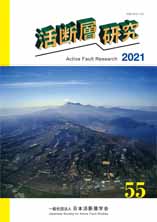
- Issue 55 Pages 1-
- Issue 54 Pages 1-
- |<
- <
- 1
- >
- >|
-
Yasuhira Aoyagi, Sadanori Higashi, Shinichi Homma, Sakae Mukoyama, Mot ...Article type: Article
2021 Volume 2021 Issue 55 Pages 1-18
Published: 2021
Released on J-STAGE: July 26, 2022
JOURNAL FREE ACCESSNear-fault deformation that is associated with surface fissures damaged Building #1 at the Aso campus of Tokai University during the 2016 Kumamoto Earthquake, which occurred along the northern extension of the Futagawa Fault System. Here we reveal the detailed features of this deformation via differential LiDAR analysis. We also map the surface ruptures in detail using UAV photo analysis and field measurements. Differential LiDAR analysis reveals that the northern and southern sides of the major cracks that traversed the northern end of the campus experienced about 1 m of northern-northeastern movement and 0.2- 0.5 m of western movement, respectively. We identify many open cracks on the eastern side of Building #1, with both a north-south tensile component and rightlateral displacement observed. However, while the north-south tensile components are dominant along the eastwest striking faults on the southwest side of Building #1, few right-lateral displacements are observed. Left-lateral faults and cracks appeared at several locations on the slope to the southwest of Building #1. The Aso campus is situated at the step-over of two mapped right-lateral faults that are separated by~400 m, with a conjugate left-lateral deformation boundary that connects the two right-lateral faults forming at this step-over due to the Kumamoto Earthquake. It is possible that the complex fault displacements observed around Building #1 have been affected by the relative movements at this step-over.
View full abstractDownload PDF (2758K)
- |<
- <
- 1
- >
- >|